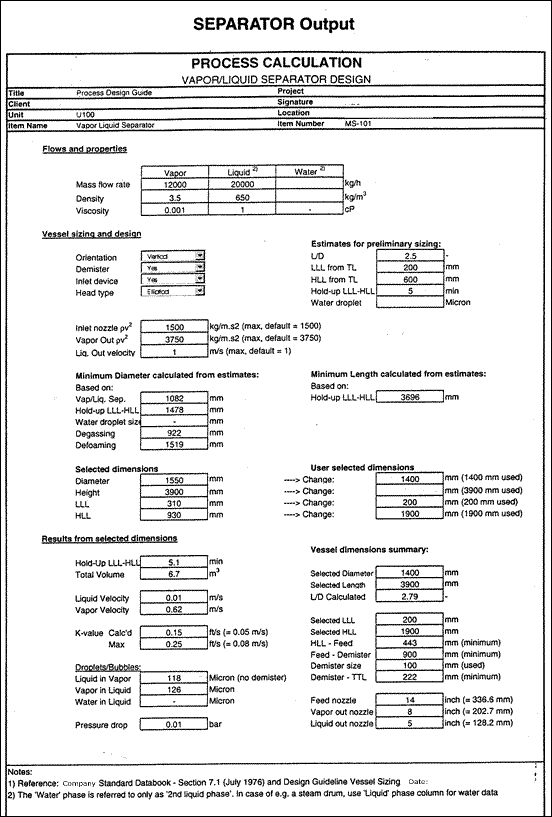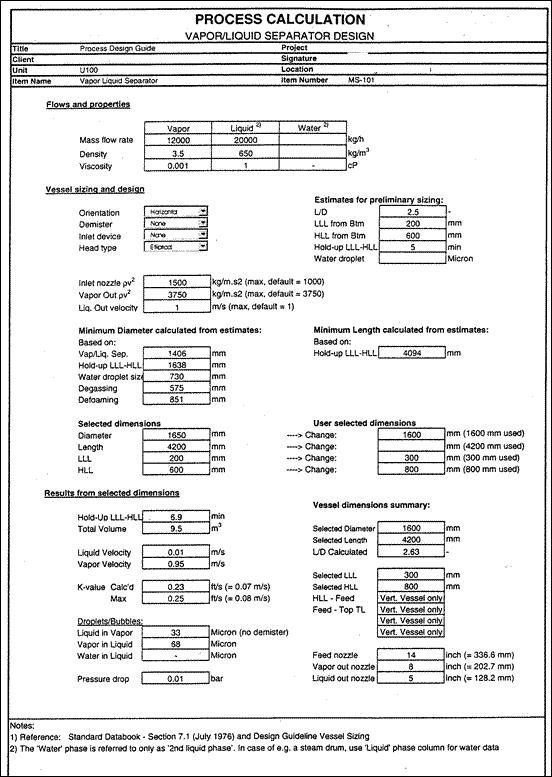Table of Contents
- Scope
- Introduction
- Selection Criteria for Vapor-Liquid Separators
- Design Criteria for Vapor / Liquid Separators
- Design of Liquid / Liquid Separators
- Computer Programs
- Appendices
1. Scope
This document shall be used for the process design of vessels, however, for specific projects, these design rules may be superseded or modified by client requirements.
Applicable design rules for a specific project shall be specified in the Design Basis and / or the General Information and Instructions (GII) for the project.
2.Introduction
In general the function of a vessel in a process unit is to either provide hold-up time or to make a separation between the various phases of a mixed process stream. In this design guide rules are given for the dimensioning of vessels, which are used for the separation of mixed process streams. They can be divided into two categories:
-
Vapor / liquid separators, which are used to separate the vapor and liquid part of a mixed stream.
-
Liquid / liquid separators, which are used to separate the two liquid phases of a mixed stream.
For both types of separators the design rules will be given in this design guide.
3. Selection Criteria for Vapor-Liquid Separators
The configuration of a vapor/liquid separator depends on a number of factors. Before making a vessel design one has to decide on the configuration of the vessel with respect to among others:
-
Orientation
-
Type of feed inlet
-
Type of internals
-
Type of heads
Factors that help to make the choice between the various alternatives are discussed in this chapter.
3.1 Orientation of the Vessel
The selection of the orientation of a gas-liquid separator depends on several factors. Both vertical and horizontal vessels have their advantages. Depending on the application one has to decide on the best choice between the alternatives.
Advantages of a vertical vessel are:
-
a smaller plot area is required (critical on offshore platforms)
-
it is easier to remove solids
-
liquid removal efficiency does not vary with liquid level because the area in the vessel available for the vapor flow remains constant
-
generally the vessel volume is smaller
Advantages of a horizontal vessel are:
-
it is easier to accommodate large liquid slugs;
-
less head room is required;
-
the downward liquid velocity is lower, resulting in improved de-gassing and foam breakdown;
-
additional to vapor / liquid separation also a liquid / liquid separation can be achieved (e.g. by installing a boot).
The preferred orientation for a number of typical vapor / liquid separation applications are:
| Application | Preferred orientation |
| Reactor Effluent Separator (V/L) | Vertical |
| Reactor Effluent Separator (V/L/L) | Horizontal |
| Reflux Accumulator | Horizontal |
| Compressor KO Drum | Vertical |
| Fuel Gas KO Drum | Vertical |
|
Flare KO Drum |
Horizontal |
| Condensate Flash Drum | Vertical |
| Steam Disengaging Drum | Horizontal |
3.2 Feed Inlet
3.2.1 Inlet Nozzle
The feed nozzle size and the type of feed inlet device (if any) have an impact on the vapor / liquid separation that can be achieved. The feed nozzle is normally sized to limit the momentum of the feed. The limitation depends on whether or not a feed inlet device is installed.
3.2.2 Inlet device
Various inlet devices are available to improve the vapor / liquid separation. Among others the following inlet devices may be installed:
-
a deflector baffle
-
a slotted tee distributor
-
a half-open pipe
-
a 90 ° elbow
-
a tangential inlet with annular ring
-
a schoepentoeter
For vertical drums, preferably a deflector baffle or a half open pipe shall be selected. In case of a slug flow regime in the inlet piping, or if a high liquid separation efficiency is required, a tangential inlet nozzle with annular ring can be used. However, in case a high liquid removal efficiency is required, the application of a wire mesh demister is preferred.
For horizontal drums normally a 90° elbow or a slotted diverter is installed. In some cases a submerged inlet pipe is installed, but this shall not be done in the case of a two-phase feed.
Normally the selected inlet device for a horizontal drum shall be:
-
a 90° elbow or a slotted diverter in case of an all liquid or vapor-liquid feed
-
a submerged pipe when the feed is a subcooled liquid and the mixing of liquid and blanket gas is to be minimized
-
two 90° elbow inlets in case of high vapor loads
3.3 Internals
After passing through the feed inlet, the vapor stream will still contain liquid in the form of droplets. The maximum size of these entrained droplets depends on the vapor upflow velocity. A separation device can reduce this entrainment significantly. Wire mesh demisters are the most commonly used as separation device. They are used for two reasons:
-
To minimize entrainment
Of the drum services having such a requirement, suction drums for reciprocating compressors are the most notable examples
-
To reduce the size of a vessel
The allowable vapor velocity in a drum can be increased significantly by using a wire mesh demister. So, when sizing is governed by vapor-liquid separation criteria, this will result in a smaller diameter of the vessel
Major disadvantages of wire mesh demisters are:
-
They are not suitable for fouling services
-
Their liquid removal decreases significantly at reduced throughput
Although the size of the vessel often can be reduced by applying a wire mesh demister, there are also many services where there is normally no demister installed. Reflux accumulators, for example, seldom have mist eliminators.
There are several other types of mist eliminators such as vanes, cyclones, and fiber beds. They are used when conditions are not favorable for wire mesh screens. Selection criteria for these types of internals are the required efficiency, capacity, turndown ratio, maximum allowable pressure drop and fouling resistance. These types however will not be further addressed in this design guide.
3.4 Vessel Head
Most vessels have 2:1 elliptical heads, welded to the shell of the vessel. However, in some cases other types of heads are used. The major alternatives are:
-
Flat heads
In case of small vertical vessels (diameter less than approximately 30”) often a flanged top head is used, which also serves to provide access to the vessel. Depending on the pressure rating, this type of head can either be flat or elliptical, and shall be selected in consultation with the mechanical engineer
-
Hemispherical heads
A hemispherical head should be considered for an extremely large, high-pressure vessel
-
A dished head should be considered in the case of a large diameter, low-pressure vessel
4. Design Criteria for Vapor / Liquid Separators
4.1 Definition of Levels
In the sizing of vessels the proper definition of hold-up time and liquid levels is important. For the design of vessels the following shall be used:
| Liquid hold-up time | Working volume between High Liquid Level (HLL) and Low Liquid Level (LLL) |
| HLL | Upper end of the control span |
| LLL | Lower end of the control span |
| HLA | High Level Alarm, normally at 90% of the control span |
| LLL | Low Level Alarm, normally at 10% of the control span |
4.2 Vertical Vessels
4.2.1 Diameter of a Vertical Vessel
The design of a vapor-liquid separator is based on the terminal settling velocity of a liquid droplet of specified size, settling under the influence of gravity. This velocity is given by:
![]()
(4.1)
where

The vapor handling capacity (Kt) depends on the type of service of the vessel. Typical values are:
| Application | Kt | |
| Horizontal KO drum | 0.25 fps | 0.08 m/s |
| Vertical KO drum without demister | 0.15 fps | 0.05 m/s |
| Vertical KO drum with demister | 0.25 fps | 0.08 m/s |
| Flare KO drum (essentially dry vapor) | 0.25 m/s | |
| Flare KO drum (wet vapor) | 0.10 m/s | |
The separator shall be large enough to handle the gas flow rate under the most severe process conditions. For systems, which have a foaming tendency, such as glycol and amine solutions, a derating factor of 0.7-0.8 shall be used for Kt. A derating factor of 0.7-0.8 shall also be used for compressor suction knockout drums.
See paragraph 4.6 for the sizing of the demister mat
4.2.2 Height of a Vertical Vessel
The total vessel height is the sum of the following contributions:
- The height required for the Low Liquid Level (LLL)
The level instrument determines the LLL. For mechanical reasons, the nozzle of this instrument should be at least 150 mm above the bottom tangent line. The level instrument requires an additional 50 mm. Therefore, the LLL is about 200 mm above the bottom TL of a vessel. In case of doubt the instrument engineer shall be consulted on the minimum required LLL. - The height required for the liquid hold-up
The liquid hold-up is defined as the volume between the High Liquid Level (HLL) and the Low Liquid Level (LLL). This volume consists of the standard hold-up plus additional volume in case of slug or trip-alarm levels. Typical hold-up times are:
Service Recommended hold-up Feed to distillation column, reactor, heater 5-15 min Reflux vessel 3-5 min Flare KO drum 20-30 min Condensate Flash drum 3-5 min Fuel Gas KO drum 1)Fuel Gas KO drum 1) 1) As a minimum a Fuel Gas KO drum shall be sized to contain a slug of liquid equivalent to the content of 6 mtr inlet piping.
If slugs of liquid can be expected, additional volume shall be provided to ensure that the required vapor / liquid separation can still be achieved. - The clearance between the High Liquid Level and the inlet nozzle
The clearance between the HLL and the inlet nozzle shall be 0.3 times the vessel diameter, with a minimum of 0.3 m. - The diameter of the inlet nozzle
The diameter of the inlet device depends on the inlet flow and on the type of inlet device. See section 4.5.1 for the sizing criteria of the inlet nozzle. - The clearance between the inlet device and the top TL
The required clearance between the inlet nozzle and the top TL depends on the presence of a demister.
- Without a demister, the clearance shall be 0.7 times the vessel diameter with a minimum of 0.9 m.
- With a demister, the clearance shall be:
0.45 times the vessel diameter, with a minimum of 0.9 m to the demister, plus, 0.1 m for the demister, plus
0.15 times the vessel diameter, with a minimum of 0.15 m for the clearance between the demister and the top TL
The sizing is for a vertical vessel with and without a demister is summarized in figure 4.1.
4.3 Horizontal Vessels
4.3.1 Size of a Horizontal Vessel
The calculation of the diameter and the length of a horizontal vessel can not be separated. The cross-sectional area of the vapor space is based on a maximum allowable vapor velocity given by equation 4.1. The sizing of a horizontal vapor / liquid separator is based on a trial-and –error method. The sizing method consists of the following steps:
- Calculate the required liquid volume (Vliq) based on the selected liquid holdup time. The liquid volume is given by:

(4.2)
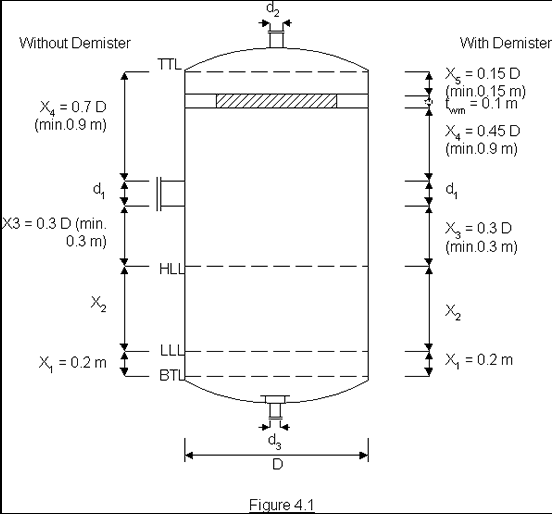
-
As a first estimate, assume that the liquid volume is 60 % of the total volume. Select an L/D ratio and calculate the vessel diameter. The vessel diameter is given by:

(4.3)where:
D the diameter of the vessel (m), L/D the ratio between the length and the diameter (-). If there are no other factors, which determine the L/D ratio of a vessel, the design pressure is normally used to select this ratio. Recommended L/D ratio’s are:

-
Select the Low Liquid Level (LLL). Typically the LLL is set at 0.2 m, but it shall be checked with the mechanical engineer whether this is feasible. Calculate the cross-sectional area below the LLL , using the following set of equations:
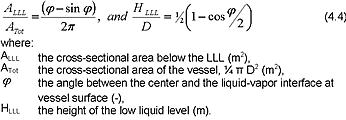
(4.4)In Excel a special function is available for this calculation.
-
Calculate the total cross-sectional area required for the liquid by adding to the cross-sectional area below the LLL the area required for the liquid hold up. The total liquid cross-sectional area is given by:

(4.5) - Calculate the HLL, using similar formula’s as in step 4, or the special function in Excel. Determine the remaining vapor cross-sectional area.
- Calculate maximum allowable vapor velocity using
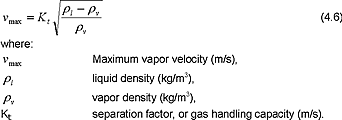
(4.6)For horizontal vessels Kt shall be taken as 0.25 fps (0.08 m/s).
- Check the actual vapor velocity.
Based on the vapor space above the HLL, the actual vapor space must be calculated and compared against the maximum allowable vapor velocity. In case of a large required vapor area, two vapor inlet nozzles shall be considered, thereby reducing the required vapor space by 50%.
Based on the application some additional criteria apply:
A. Limitations on HLL
The HLL shall not be higher than 80% of the diameter, with a minimum height of the vapor space of 0.3 m. If a demister is installed, the minimum height of the vapor space is 0.6 m
B. Space for inlet device
The vapor space must be sufficiently high to accommodate the feed inlet device. At least 150 mm shall be available between the bottom of the inlet device and the HLL
4.3.2 Feed Inlet Device for Horizontal Vessels
Either a 90°elbow, or a half-open pipe can be used as inlet device for a horizontal vessel. A 90°elbow is preferred, as they are easier to fabricate. The following requirements are applicable for 90°elbow inlets:
- The diameter of the elbow must be the same as the nozzle diameter.
- An impingement baffle should be installed opposite to the elbow to protect the drum shell. The baffle diameter should be twice the inlet nozzle diameter. A thickness of ¼“ for the baffle plate is recommended.
- The minimum distance between the elbow and the HLL is 150 mm (6”).
- The elbow should be installed as close as possible to the tangent line considering reinforcement and fabrication requirements (150 mm).
- Short radius elbows shall be used, with 3“ straight pipe inside the drum.
4.3.3 Boot
When there is a chance that the liquid contains some water or other immiscible fluid a boot can be provided to collect the heavier fluid phase. A boot will only be selected if the following criteria are satisfied:
- "De-oiling" of the heavy liquid phase is not important
- The ratio of the volumetric flow rates of the heavy and light liquid phase is smaller than 0.2
In all other cases overflow/underflow weirs shall be used for proper liquid/liquid separation.
The sizing of the boot diameter shall satisfy the following criteria:
- The boot diameter shall not be more than 0.5 times the vessel diameter
- The minimum boot diameter depends on the diameter of the vessel, and shall be as listed below:
| Vessel Diameter (mm) | Min. Boot Diameter (mm) |
| D < 900 | 300 |
| 900<D<1400 | 400 |
| D>1400 | 500 |
- The heavy liquid draw-off velocity shall not exceed 80% of the rising velocity of the light liquid. Because of the small size of the droplets, in most cases the Stokes law can be applied to calculate the rising velocity of the droplets.This results in:
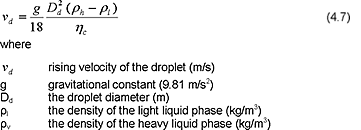

Moreover, the design settling velocity should be limited to 10 inch per minute even if a higher rate is calculated.
The length of a boot shall be based on the following criteria:
- Typically, allow about 5 minutes hold up for the heavy phase
- The length of the boot (i.e. the distance between the bottom of the vessel and the bottom tangent line of the boot) should be at least 900 mm
to allow a proper interface level control and to accommodate all the nozzles for the control instruments - The low liquid level for the liquid-liquid interface should be 200 mm above the bottom tangent line. The high liquid level should be 200 mm below the bottom of the vessel. This results in a distance between the low and high level of the liquid-liquid interface of at least 500 mm
Additional vessel requirements when providing a boot:
- The light liquid phase outlet shall extend 100 to 150 mm above the bottom of the vessel, and be equipped with a vortex breaker
- The light liquid phase outlet shall be located downstream of the boot and as close as possible to the tangent line of the vessel
- The boot shall be located on the opposite side form the inlet, as close as possible to the tangent line. The distance is not determined by process reasons, but by the saddle support. Therefore, contact with the mechanical department is required
4.4 Additional Criteria
4.4.1 Degassing
When good degassing of liquid is required, the dimensioning of the vessel shall also satisfy criteria for the separation of gas bubbles out of the liquid phase. Because of the small size of the bubbles, in most liquids the Stokes law can be applied to calculate the rising velocity of the bubbles. This results in:
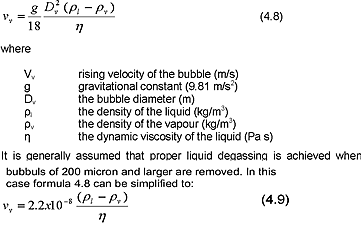
For vertical vessels it shall be ensured that the downward liquid velocity in the vessel doesn't exceed the calculated rising velocity of the bubbles.
For horizontal vessels it shall be ensured that the residence time below the low liquid level will allow the selected minimum size bubble to travel the distance between the vessel bottom and the low liquid level.
4.4.2 Foaming
In case the liquid handled has a tendency to foam, the design shall take this into consideration. Although there is no solid basis to do so, the following can be used as a guide:
- For horizontal vessels, add the height of the foam above the high liquid level, to allow for the reduced vapor space for vapor/liquid disengagement. (typically 0.3 mtr or 1 ft)
- For vertical vessels, Company limits the downwards liquid velocity to:
![]()
(4.10)
4.5 Sizing of Nozzles
4.5.1 Feed Inlet Nozzle
The internal nozzle diameter may be taken equal to that of the feed pipe, but also the following momentum criteria shall be satisfied:

Other momentum criteria are applicable for high vacuum units or other units where the inlet velocity can be very high because of the low gas density.
4.5.2 Vapor Outlet Nozzle
The diameter of the gas outlet nozzle should normally be equal to that of the outlet pipe, but also the following criterion shall be satisfied:

In High Vacuum Units this criterion may result in a high outlet velocity, leading to a pressure drop which is too high. In that case, the gas outlet nozzle shall be sized such that the pressure drop requirements between column and downstream system are met.
4.5.3 Liquid Outlet nozzle
The diameter of the liquid outlet nozzle shall be chosen in relation to the outlet line size selected, and is often based on a liquid velocity of 1 m/s. As liquid circulating above the liquid outlet nozzle may result in vortex formation, the design shall include measures to avoid this. This can be done in two ways:
- Allow adequate liquid height above the outlet nozzle. For checking the required minimum liquid height above the outlet nozzle see graphs in Appendix I.
- Install a vortex breaker
Normally vortex breakers are provided on outlet nozzles that serve as outlet to a pump.
4.5.4 Manway
The size of a manway is usually 24”, unless internal devices require larger size for installation. If the vessel diameter is 30” or less, a flanged head may be considered in stead of a manway. For mechanical reasons manways should be smaller than one-half of the vessel inside diameter.
As an alternative to a manway, smaller vessels can be provided with an inspection hole, which is normally 8”.
4.5.5 Vents and Drains
As defined in the Engineering Guide for the Preparation of Engineering Flow Diagrams (BN-EG-UE208), para. 5.2.4 the size of vents and drains on vessels shall be:
| Vessel volume | Drain Connection | Vent Connection |
| Up to 17 m3 | 2” | 2” |
| 17 to 200 m3 | 3” | 3” |
| 200 to 400 m3 | 3” | 4” |
| 400 to 700 m3 | 4” | 6” |
| 700 m3 and above | 6” | 8” |
Additional to vents and drains vessels may be provided with steam out and utility connections. Normally these connections are 2”.
4.5.6 Nozzle Identification
If not specifically defined for the project, the nozzles on a vessel shall be identified as follows:
|
Process nozzles |
N1, N2, N3 etc. |
|
Instrument nozzles |
K1, K2, K3 etc., where multiple nozzles for a single instrument shall be identified K1A\B\C etc |
|
Manways |
M1, M2 etc. |
|
Relief Valves |
RV1, RV2 etc. |
|
Vents |
V1,V2 etc. |
|
Drains |
D1, D2 etc. |
|
Steam out connections |
SO |
|
Utility connections |
UC |
4.6 Mist Eliminators
In case a high liquid separation efficiency is required, a mist eliminator can be installed to ensure the removal of smaller liquid droplets. Also a mist eliminator can be installed to reduce the size of a vertical vapor / liquid separator. Normally a demister pad is installed as mist eliminator.
Important: In case a vessel is provided with a demister pad, the relief valve protecting the vessel shall be mounted upstream of the demister pad to reduce the change of blockage in the relief valve inlet and to reduce pressure drop.
4.6.1 Sizing of Demister Pads
The demister pad is sized based on a maximum allowable vapor velocity through the pad, given by vendor rules. A typical sizing rule for demister pads is given by equation 4.13 however for separators operating under vacuum conditions vendor information shall be consulted.

The demister thickness is normally 100 mm or 4”.
4.6.2 Demisters in Vertical Vapor / Liquid Separators
For vertical vessels the details on demister installation and vessel sizing are given in para. 4.2.
4.6.3 Demisters in Horizontal Vapor / Liquid Separators
For horizontal vessels the following applies for the use of demister pads.Horizontally installed demister pads:
- The minimum clearance between the top of the vessel and the demister pad is the larger of 12” or half the length of the longer side of the pad.
- The design of the vessel remains the same as for a horizontal vessel without mist eliminator. except for the minimum length, which is not specified from inlet to outlet nozzle but from inlet to demister pad.
- In case the separation efficiency of the vessel should be very high, two vertical and one horizontal demister can be installed in the vapor phase. The vessel requires an inlet nozzle at each end, terminated by an elbow or a half-open pipe, and one vapor outlet nozzle at the center of the vessel. This setup reduces the required cross-sectional vapor area by 50%. However, with small low-pressure vessels, the savings from the smaller diameter may be offset by the cost of the vertical demisters and the extra inlet.
For vertically installed demister pads:
- The minimum thickness of the demister pad is 6”
- The demister pad should extend from the top of the vessel to 0.1 m above the bottom. The area between the mat and the bottom of the vessel shall allow free passage of liquid.
- The distance between the inlet device and the front face of the demister mat shall be at least 0.6 m or 0.5 times the vessel diameter
- The distance between the downstream side of the outlet nozzle and the rear face of the demister mat shall be at least 0.5D.
5. Design of Liquid / Liquid Separators
Normally, liquid / liquid separation is achieved in a horizontal vessel, providing adequate residence time to properly separate the required droplet size from both the liquid phases. The most commonly used types are:
- Completely filled vessels with liquid draw-off via nozzles at the top and bottom of the vessel
- Vessels also providing vapor space, with overflow and underflow baffles, which are separating the liquid / liquid separation compartment from compartments for liquid draw-off
The former type of separator is used when there is no chance of vapor formation, while the latter is used when there is a chance of vapor formation.
Rules for the design of coalescor type liquid / liquid separators, where the separation is enhanced by internals (e.g. plate packs, wire mesh), are not given in this design guide. Design rules for this type of separator shall be based on vendor information.
5.1 Liquid-Filled Separators
The sizing of a liquid filled liquid / liquid separator is based on the required residence time for:
- separating small droplets of light fluid from the heavy phase fluid
- separating small droplets of heavy fluid from the light phase fluid
Based on the type of application, one of the two above mentioned criteria may be skipped.
The sizing of this type of liquid / liquid separator is based on trial and error and requires the following steps:
1. Select vessel dimensions and interface levels (min. and max.)
Initial vessel dimensions can be selected based on an overall liquid residence time, e.g. 15 minutes. Initial high and low interface levels can be selected to get a hold-uptime for the larger of the two phases of approximately 3 minutes (for control purposes), and about identical hold-up times for both phases, with the interface at the normal level.
2. Calculate the droplet settling velocity for both phases
Because of the small size of the droplets, in most cases the Stokes law can be applied to calculate the settling velocity of the droplets. This results in:
![]()
(5.1)
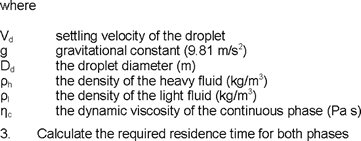
The required residence time must be calculated for both phases, to allow the selected droplet size to travel between the interface and the top or bottom of the vessel. These residence times must be compared with the actual residence time of both phases at the interface. Because of the shape of the vessel, it is required to check the required residence time of both phases against the actual at various interface levels, e.g. at the low and high interface level.
Based on the outcome of the calculations a new set of (high and low) interface levels can be selected, or a new size vessel.
5.2 Liquid-Liquid Separators with Vapor Compartment
A liquid / liquid separator with a vapor compartment is well known, and often used as the accumulator of an ejector based vacuum system. The sizing of these horizontal vessels includes the sizing based on vapor / liquid separation as described before and the sizing of the liquid / liquid separation. In this section only the sizing for liquid / liquid separation is discussed. In case there is only a very small amount of vapor flowing through the vessel, the High Liquid Level shall be taken at max. 80% of the diameter of the vessel.
The liquid / liquid separators with a vapor compartment have three liquid compartments, one for the liquid / liquid separation and one each for the hold-up of the separated light and heavy phase. These compartments are separated by overflow and underflow baffles, which ensure a proper hold up time of the two phases in the separating compartment.
Also the sizing of this type of liquid / liquid separator is based on trial and error and requires the following steps:
1. Select vessel dimensions
Initial vessel dimensions can be selected based on an overall liquid residence time, e.g. 15 minutes with a HLL at 80% of the vessel diameter.
2. Select the heavy phase overflow baffle height and calculate the resulting interface
By selecting the height of the heavy phase overflow baffle the liquid / liquid interface can be calculated based on a pressure balance, using the following equation:
H1 x ρh = Hh x ρh + (H2-Hh) x ρl
Where:
H1 the height of the heavy phase overflow baffle
H2 the height of the light phase overflow baffle
Hh the height of the heavy phase in the separation compartment
ρh the density of the heavy fluid (kg/m3)
ρl the density of the light fluid (kg/m3)
As a starting value for H1 take it approximately 200 mm below H2.
3. Position the baffles
The overflow baffles must be positioned to get adequate hold up in the overflow compartments for proper control of the outgoing fluid. Normally a hold up of approximately three minutes between a HLL and LLL is adequate.The distance between heavy phase underflow and overflow normally is 200 mm, however this shall be checked to minimize pressure drop.
4. Check the liquid / liquid separation
To check the liquid / liquid separation the droplet settling velocity for both phases must be calculated. Because of the small size of the droplets, in most cases the Stokes law can be applied to calculate the settling velocity of the droplets. This results in:
![]()
(5.2)
where
Vd settling velocity of the droplet (m/s)
g gravitational constant (9.81 m/s2)
Dd the droplet diameter (m)
ρh the density of the heavy fluid (kg/m3)
ρl the density of the light fluid (kg/m3)
ηc the dynamic viscosity of the continuous phase (Pa s)
Based on the calculated interface level and settling velocities the required residence time for the light and heavy fluid must be calculated and compared with the actual residence times.
Based on the outcome of the calculations some of the assumed values have to be adjusted. In case there are only minor differences between the actual and required residence times, adjustment of the overflow and underflow baffles (in height and / or location) will be sufficient, in the case of larger differences, the overall size of the vessel will have to be adjusted.
Because of the fixed overflow baffles, the interface level will change with changes in fluid densities. As this affects the separation, the design shall be checked for possible changes in these densities. For the same reason it is recommended to have the top of the heavy fluid overflow baffle adjustable (e.g. +/- 100 mm)
5. Check vapor / liquid separation
As a final check on the dimensions, the vapor / liquid separation must be checked based on the vapor residence time and the settling velocity of the light fluid droplets to be removed from the vapor.
6. Computer Programs
Various computer applications have been developed for the sizing of vapor \ liquid separators. These are:
6.1 Depsep
This program has been developed to size vapor \ liquid separators based on the "Company" rules. A typical output is given in Appendix IV.
6.2 Separator
This program, originally a Lotus 123 spreadsheet, has been developed to size vapor \ liquid separators based on "Company" rules.
Some typical outputs are given in Appendix V.
6.3 Excel Functions
In Excel a number of special functions have been developed to calculate vessel characteristics. Among other the following functions have been developed:
6.3.1 Horizontal Vessel Liquid Volume
Calculates the volume of liquid in a horizontal vessel based on vessel diameter, vessel length, liquid level and type of head.
6.3.2 Horizontal Vessel Liquid Level
Calculates the liquid level in a horizontal vessel based on:
- Vessel Diameter
- Vessel Length
- Liquid Volume
- Type of Head
(For a quick estimate refer to the 'Tools' section of the Red-Bag website.)
6.3.3 Vertical Vessel Liquid Volume
Calculates the volume of liquid in a vertical vessel based on:
- Vessel Diameter
- Vessel Length
- Liquid Level
- Type of Head
6.3.4 Vertical Vessel Liquid Level
Calculates the liquid level in a horizontal vessel based on:
- Vessel Diameter
- Vessel Length
- Liquid Volume
- Type of Head
6.3.5 Segmental Area from Elevation
Calculates the cross sectional area of a horizontal vessel below a given level based on:
- Vessel diameter
- Level height
7. Appendices
| I | Graphs |
| II | Typical Vessel Calculations |
| III | Typical Data Sheet |
| IV | DEPSEP Output |
| V | SEPARATOR Output |
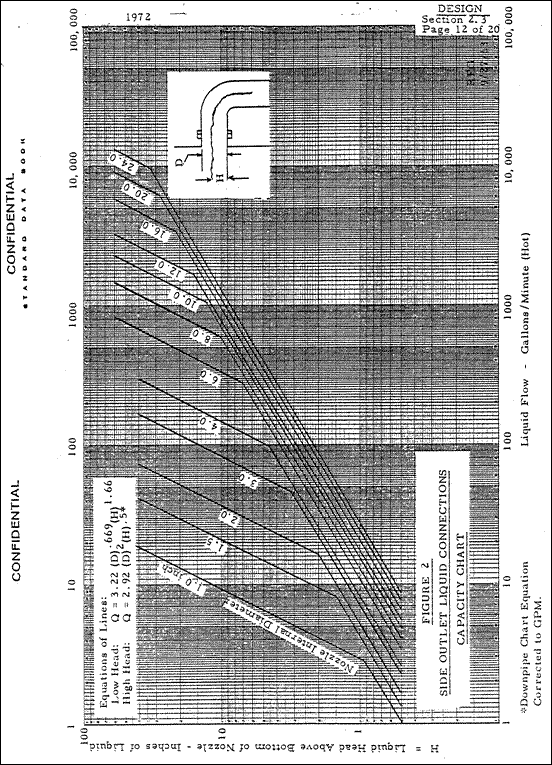
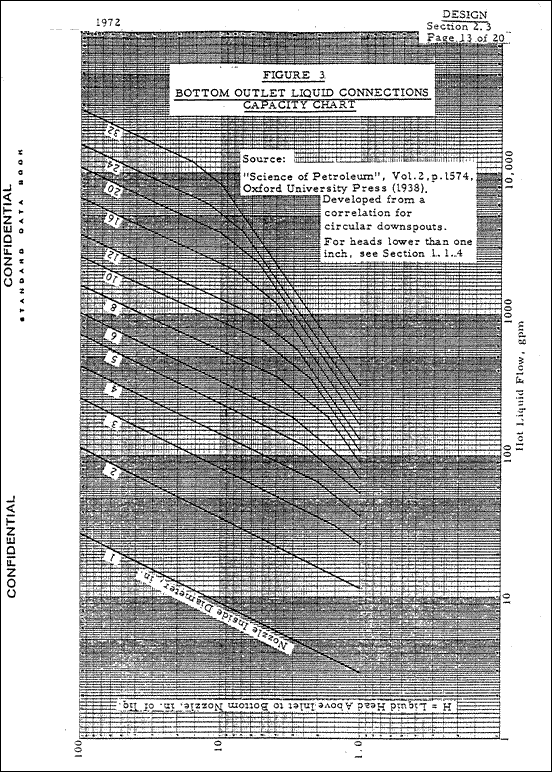
Typical Vessel Calculations
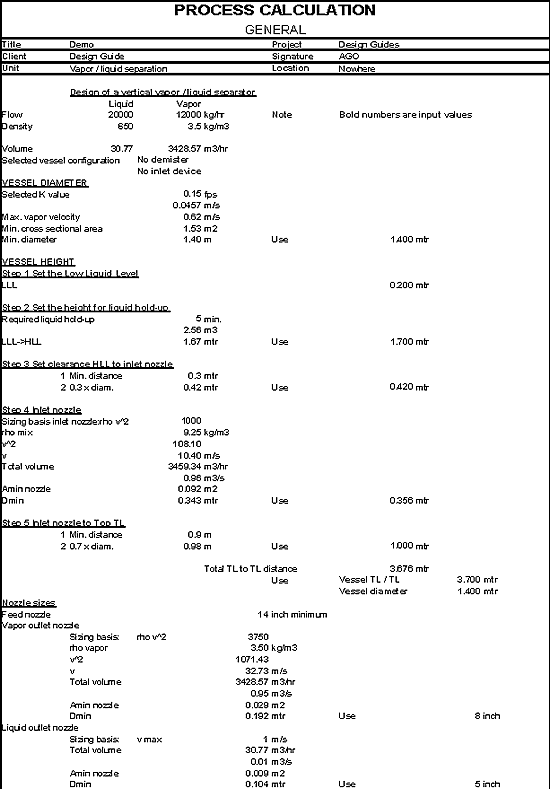
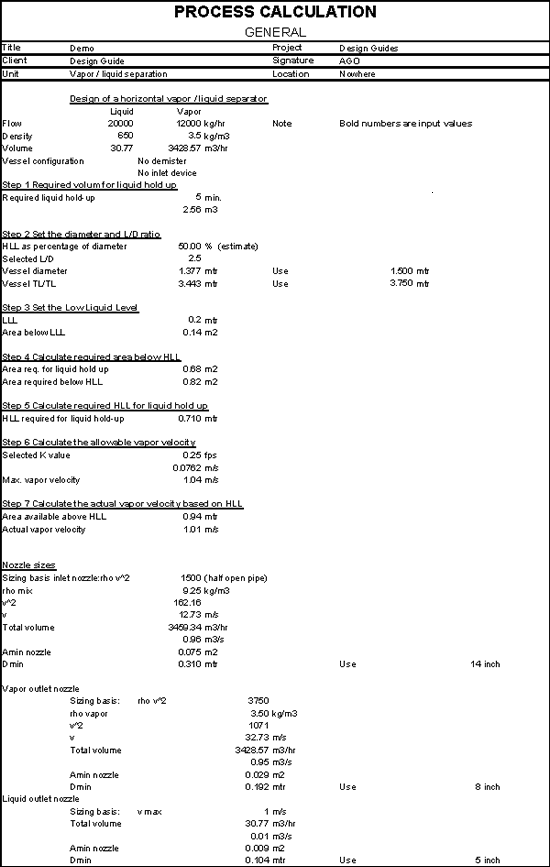
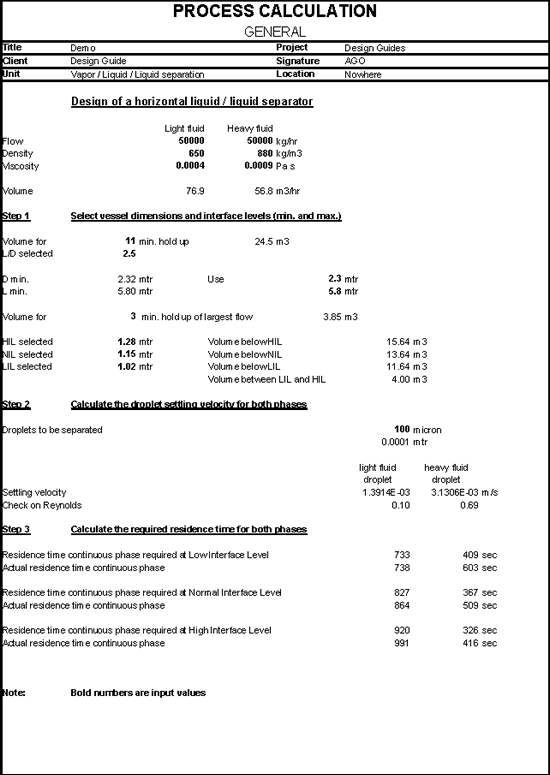
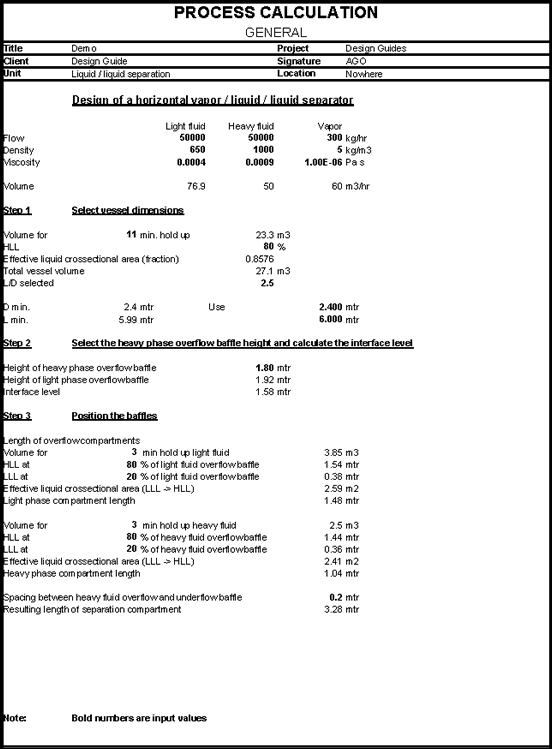
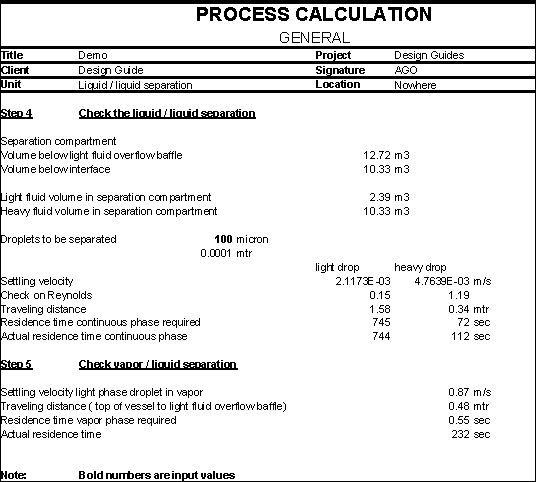
PROCESS DATA SHEETS FOR:
B211
Benzeen Destillaat Vat

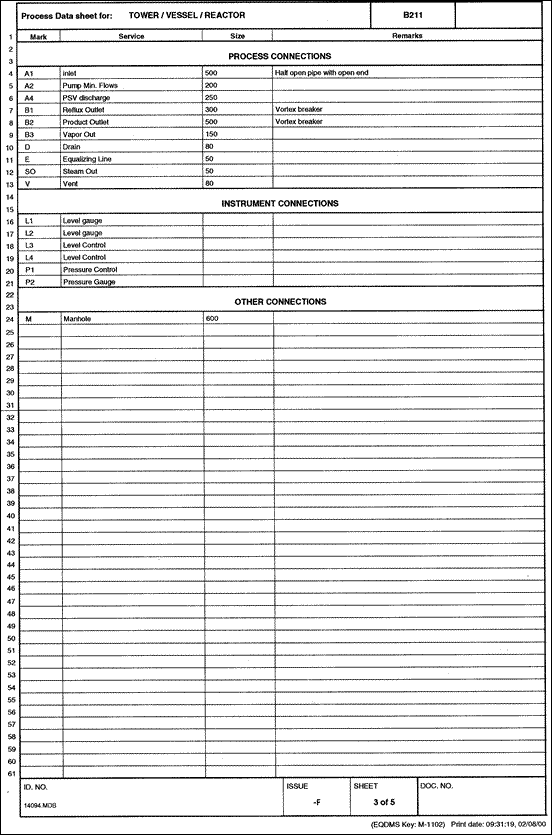
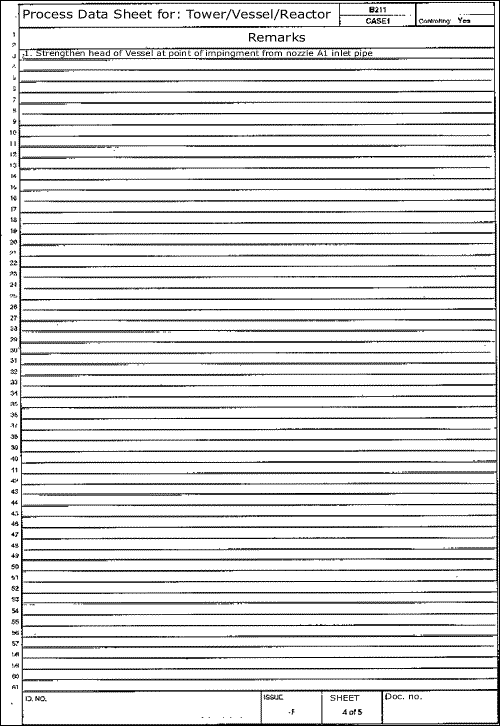
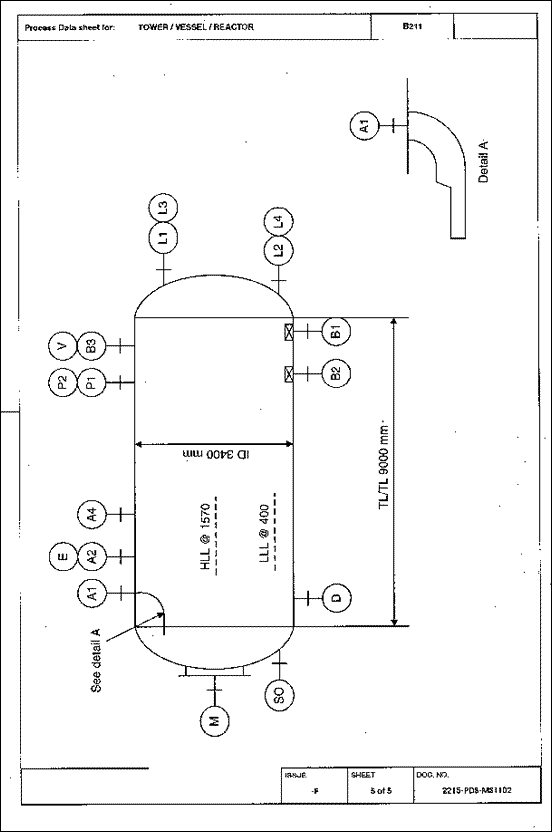
DEPSEP OUTPUT
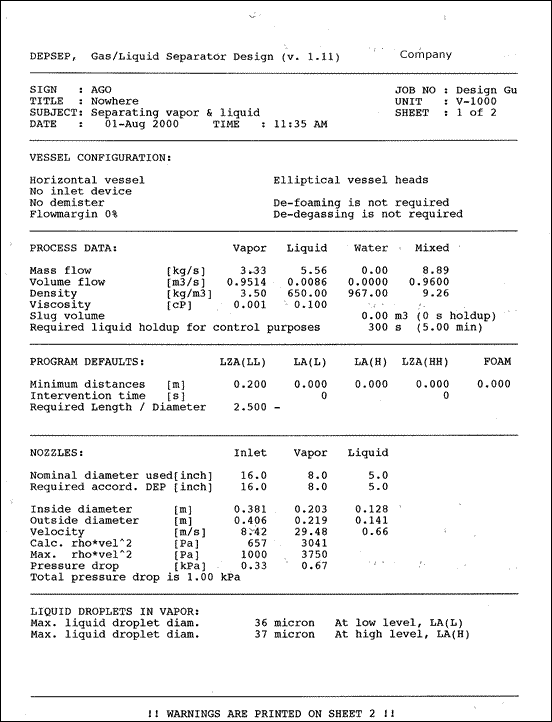
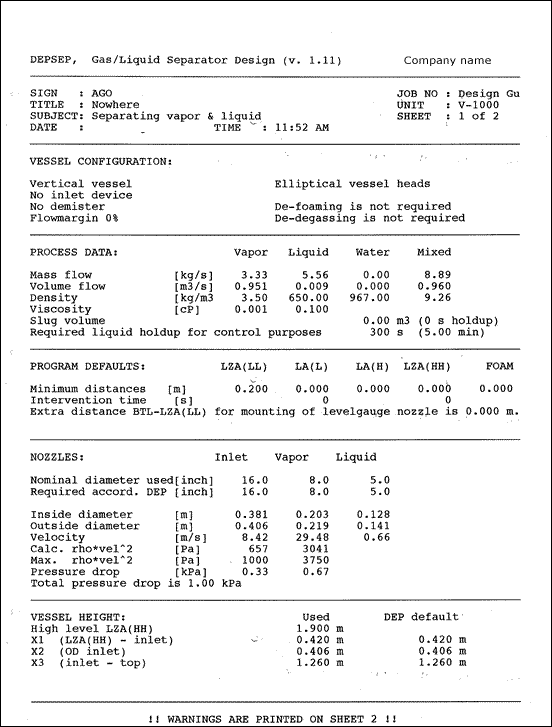
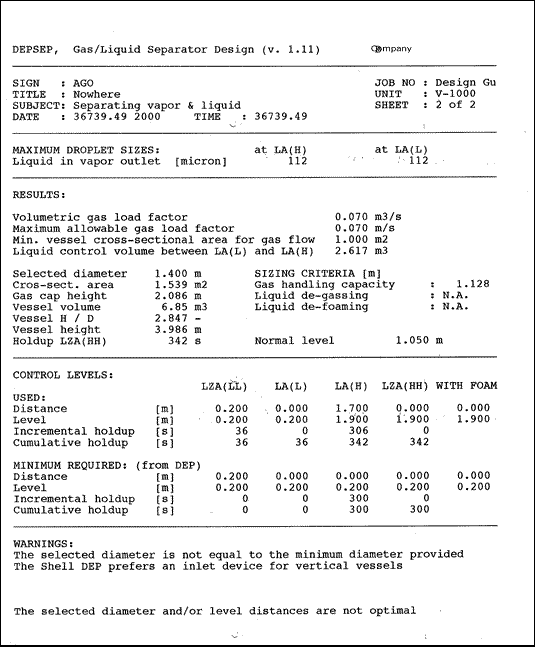
SEPARATOR OUTPUT
